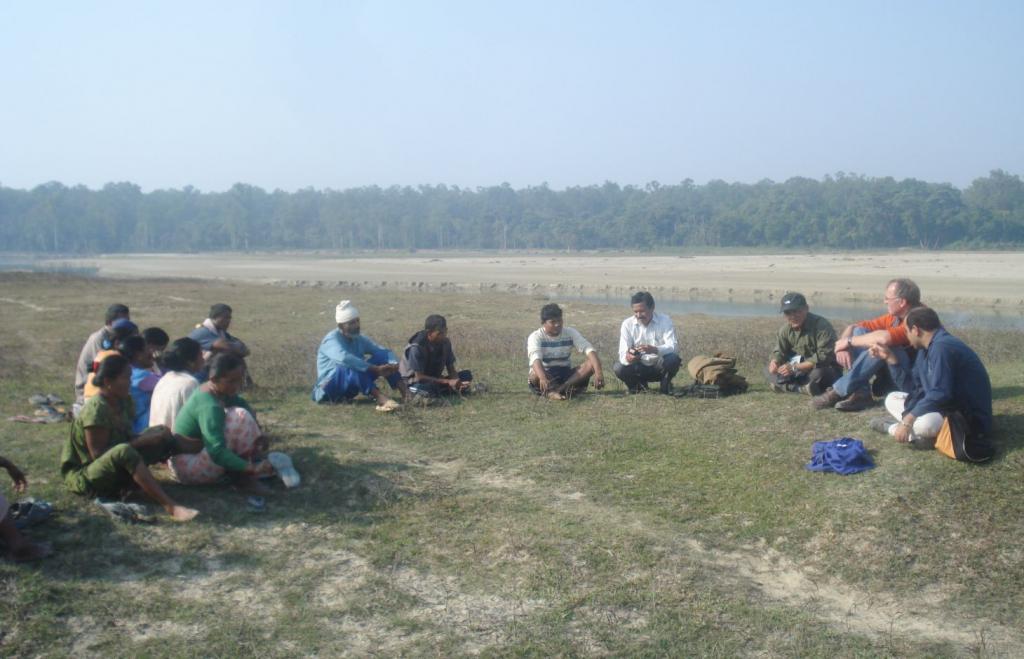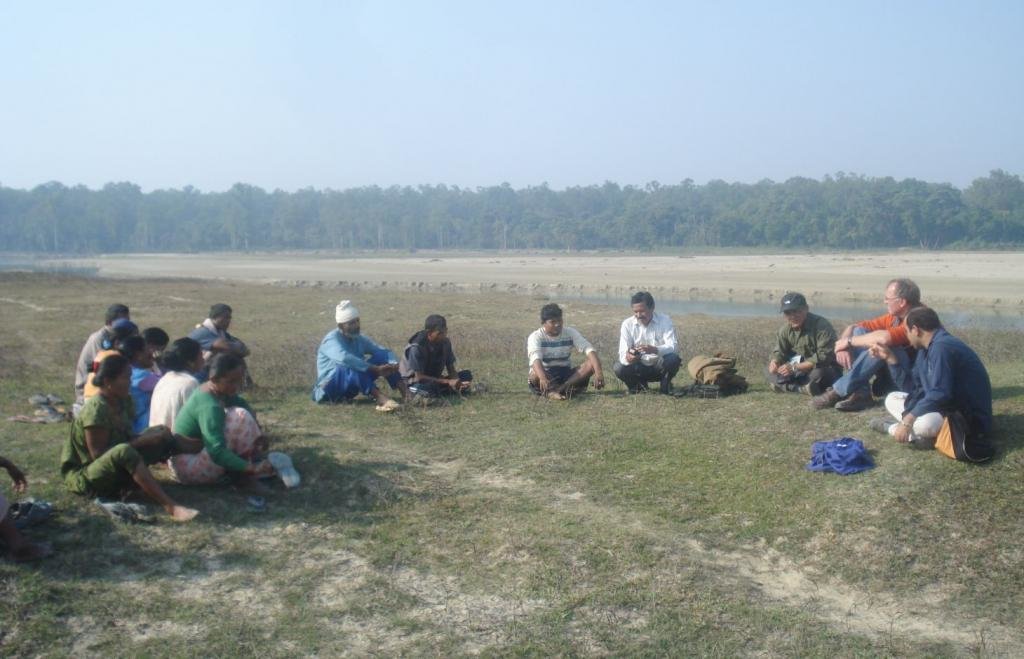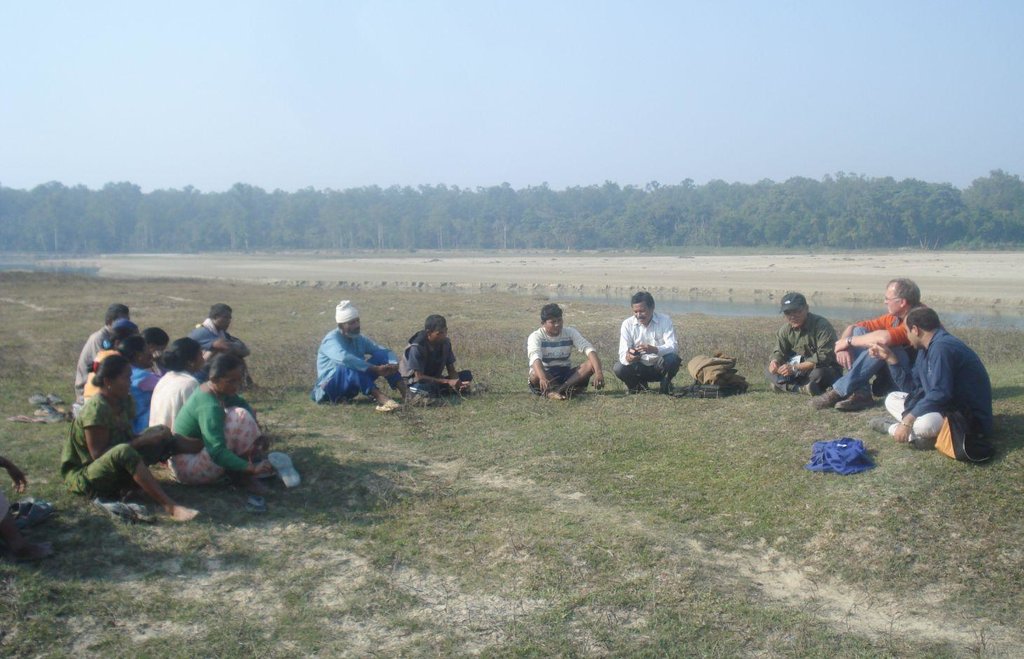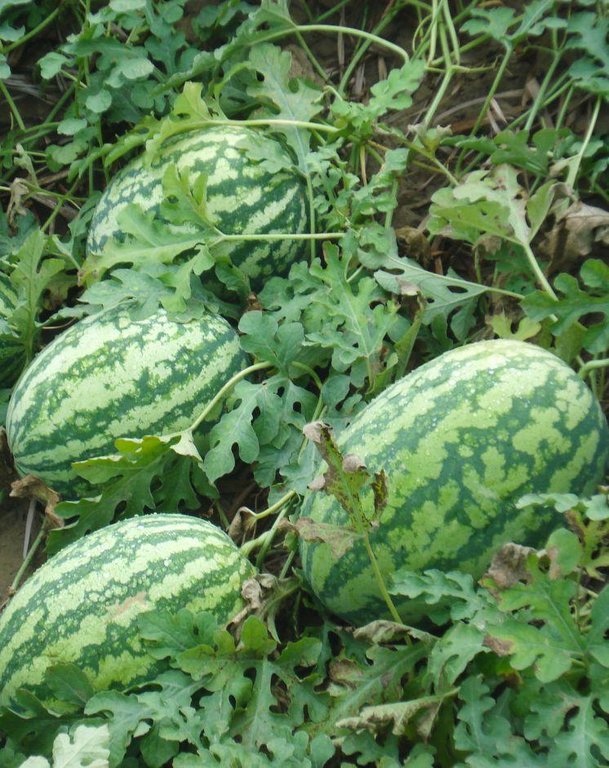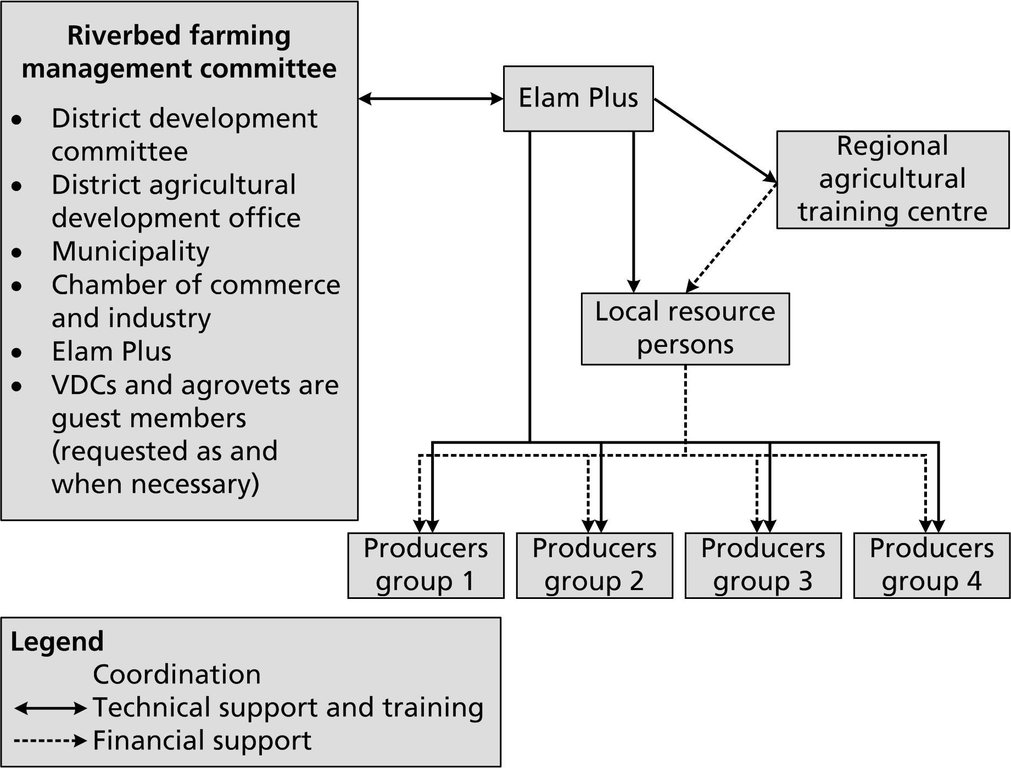Land distribution and allocation for riverbed farming [Непал]
- Создание:
- Обновить:
- Составитель: Shreedip Sigdel
- Редактор: –
- Рецензент: Fabian Ottiger
Bagare Kheti ko lagi bhumi bitaran ra bhibhajan (Main Contributor: Juerg Merz & Hari Gurung, HELVETAS)
approaches_2534 - Непал
Просмотреть разделы
Развернуть все Свернуть все1. Общая информация
1.2 Контактные данные специалистов и организаций, участвующих в описании и оценке Подхода
Специалист по УЗП:
Merz Jürg
+977 1 5524925; +977 985104442 (M)
juerg.merz@helvetas.org.np
HELVETAS Swiss Intercooperation Nepal
Швейцария
Специалист по УЗП:
Gurung Hari
+9741056444 (M)
hari.gurung@helvetas.org.np
HELVETAS Swiss Intercooperation Nepal
Непал
Название организации (-ий), содействовавших документированию/оценке Подхода (если применимо)
HELVETAS (Swiss Intercooperation)Название организации (-ий), содействовавших документированию/оценке Подхода (если применимо)
ICIMOD International Centre for Integrated Mountain Development (ICIMOD) - Непал1.3 Условия, регламентирующие использование собранных ВОКАТ данных
Когда были собраны данные (на местах)?
01/03/2013
Составитель и ответственный/-ые специалист(-ы) согласны с условиями, регламентирующими использование собранных ВОКАТ данных:
Да
1.4 Ссылка (-и) на Анкету (-ы) по Технологиям УЗП
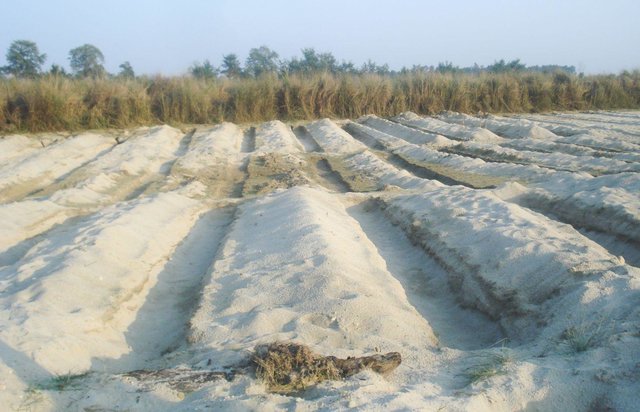
Riverbed farming [Непал]
Riverbed farming can be used to increase household income and to improve the food security of landless and land-poor households in the Terai area of Nepal.
- Составитель: Shreedip Sigdel
2. Описание Подхода УЗП
2.1 Краткое описание Подхода
Riverbed farming provides landless and land-poor households with the possibility to earn an income from on-farm activities close to home
2.2 Подробное описание Подхода
Подробное описание Подхода:
Aims / objectives: At least 20% of the households in the Terai, the plains of southern Nepal, do not own land. In order to make a living, these households commonly rely on share cropping and work in low paid off-farm jobs. The approach described here allows these farmers to make the most of the large areas of fallow land near riverbeds which are normally unclaimed and not cultivated. Since the lands near riverbeds have alluvial soils and sufficient moisture, they are suitable for seasonal vegetable cultivation during the dry season. In order for these landless and land-poor households to be able to farm these riverbed areas, they need to have access to suitable plots and the necessary agricultural inputs and training.
Methods: Potential riverbed areas are identified using topographic maps; subsequently, field verification identifies whether the selected riverbed areas are indeed suitable for cultivating horticultural crops. During the field verification, target groups in the given riverbed area are identified and the land is assessed in consultation with them. The relevant stakeholders are the village development committee and the district agricultural development office. Local resource persons are selected from target groups, which typically consist of 20 to 25 households, and are given training so that they can provide the local technical support. Once the farmer target groups have been identified and the riverbed sites selected, the group is given the legal support needed to get a leasehold agreement with the land owner, often the state. The riverbed area is then parcelled out to landless and land-poor households based on fixed selection criteria. This approach works best when the riverbed land area is at least 3 ha because it means that every target household can cultivate at least 0.13 ha (4 kattha), the least amount of land which can provide a meaningful cash income.
2.3 Фотографии, иллюстрирующие Подход
2.5 Страна/ регион/ место, где применялся Подход
Страна:
Непал
Более точная привязка места:
Kanchanpur and Kailali District
2.7 Тип Подхода
- в рамках проекта/ программы
2.8 Каковы цели/ задачи Подхода
The Approach focused mainly on SLM with other activities (income generation of poor and landless household)
Give landless and land-poor households access to riverbed land for cash crop cultivation so that they can increase their household income and their food security
The SLM Approach addressed the following problems: • A high number of landless and land-poor households subsist on share cropping and low paid off-farm work
• The number of landless and land-poor households is increasing because many farmers have lost their agricultural land due to floods, many hill farmers are migrating to the Terai, and an increasing population means that holdings are divided up into ever smaller plots
• Inadequate agricultural extension for riverbed farming
• There are no local level policies which allow landless and land-poor farmers access to marginal lands
2.9 Условия содействующие применению Технологии/ Технологий в рамках Подхода или затрудняющие его
Институциональные условия
- затрудняют
The government's extension service does not cover riverbed farming
Treatment through the SLM Approach: Local resource persons are trained and mobilized to provide agricultural extension services to riverbed farmers.
Нормативно-правовая база (землевладение, права на земле- и водопользование)
- затрудняют
Riverbeds are generally owned by the state (village development committee, municipality, or community forest users' groups) and in some cases, by private owners. The owners are reluctant to provide access to the riverbed land because of the Tenant Law. About 65% of the riverbed land is owned by the state and the rest is privately owned. Individual land right issues are discussed in the group and negotiated among group members. Generally, the choice of crops for riverbed farming depends on the type of soil and the sand moisture level; attempts are made to minimize the amount of river water used. So far, downstream farmers have not complained about any overuse of water by upstream riverbed farmers. In this regard, water rights issues are not generally raised.
Treatment through the SLM Approach: Farmers and land owners agree on a 3-year lease for riverbed land. The land is allocated according to the size of the group, the size of the land, and its location relative to the river. Each member is allocated 4 katthas (0.13 ha) perpendicular to the river flow.
A border is determined and the area is guarded at night.
Осведомленность в области УЗП, доступность технической поддержки
- затрудняют
Seeds for crops which are suitable for riverbed farming generally come from India and the local agrovets often cannot supply them on time.
Treatment through the SLM Approach: Agrovets are informed about the type of agricultural inputs needed (seeds, fertilizers, bio-pesticides) and how to supply them. Riverbed farmers are trained on how to use local and improved seeds and how to conserve and store them.
другие
- затрудняют
Unclear government policies may limit access to riverbed land and subsidies from poverty alleviation programmes
Treatment through the SLM Approach: Lobby local bodies to address issues of riverbed farming policies
3. Участие и распределение ролей заинтересованных сторон
3.1 Заинтересованные стороны, участвующие в реализации Подхода и их роли
- местные землепользователи/ местные сообщества
- эксперты по УЗП/ сельскому хозяйству
- общественные организации
Elam Plus
- государственные власти (отвечающие за планирование или принятие решений)
3.2 Участие местных землепользователей/ местных сообществ на разных стадиях реализации Подхода
| Участие местных землепользователей/ местных сообществ | Перечислите участников и опишите их вовлеченность | |
|---|---|---|
| инициирование/ мотивация | интерактивное | Group meeting conducted with key members of a group, request for follow-up forwarded to supporting organization. |
| планирование | интерактивное | The riverbed area is selected and the land is distributed to the members. The arrangements are agreed in consultation with both men and women of the producer group. |
| выполнение | самоорганизация | Land preparation, sowing, irrigation, weeding, harvesting, and marketing. Both men and women are involved. |
| мониторинг/ оценка | интерактивное | The process of requesting access to the riverbed land involves group level discussions between farmers and government officials or land owners. Key members of the group (e.g. chair person or secretary) are involved in monitoring and evaluating the success of the riverbed farming programme. |
| Research | интерактивное | Farmers pilot crop innovations based on the research design suggested by supporting organizations and they provide feedback on how successful the implementation was. |
3.3 Схема реализации (если имеется)
Описание:
committee:
• Organize, review, and plan meetings
• Decide on suppliers
• Oversee the land lease process and insure that the land is properly allocated
• Conduct field monitoring
Role of Elam Plus:
• Organize stakeholders' meetings for managing and generating resources
• Funding support
• Introduce innovations
• Train local resource persons
Role of local resource persons:
• Provide technical support to farmers
• Support producers groups to maintain records and bookkeeping
• Support producers groups to find market linkages
Role of Regional Agricultural Training Centre:
• Develop modular training package
• Train local resource persons
(AK Thaku)
3.4 Принятие решений по выбору Технологии/ Технологий УЗП
Укажите, кто принимал решение по выбору применяемой Технологии/ Технологий:
- в основном землепользователи при поддержке специалистов по УЗП
Поясните:
Farm coordinators consult with the Elam Plus team, the District Agricultural Development Office, local resource persons, and producers groups to come up with a mutually agreed technology.
Decisions on the method of implementing the SLM Technology were made by mainly by land users supported by SLM specialists. Producers groups and local resource persons work in close collaboration with farm coordinators and the enterprise development officers of Elam Plus.
4. Техническая поддержка, повышение компетенций и управление знаниями
4.1 Повышение компетенций/ обучение
Проводилось ли обучение землепользователей/ других заинтересованных лиц?
Да
Укажите, кто проходил обучение:
- местный персонал/консультанты
Тип обучения:
- Technical training and extension services
Рассматриваемые темы:
The Regional Agricultural Training Centre of the Department of Agriculture trains the local resource persons. Once trained, they help to raise awareness among landless and land-poor farmers of the advantages of riverbed farming and they also give them technical training and extension services
4.2 Консультационные услуги
Есть ли у землепользователей возможность получать консультации?
Да
Укажите, где именно оказываются консультационные услуги:
- на полях землепользователей
Описание/ комментарий:
Name of method used for advisory service: Training; Key elements: The District Agricultural Development Office provides plant protection expertise and Elam Plus provides technical backstopping and field learning.
4.3 Институциональная (организационная) поддержка
В ходе реализации Подхода были ли организованы новые институциональные структуры или поддержаны уже существующие?
- да, умеренно
Укажите уровень, на котором структуры были укреплены или вновь созданы:
- местные
Укажите тип поддержки:
- повышение компетенций/ обучение
Подробнее:
Local resource persons form their own organizations and their capacity is strengthened.
4.4 Мониторинг и оценка
Являются ли мониторинг и оценка частью Подхода?
Да
Комментарии:
technical aspects were monitored through measurements; indicators: In total, 35 local resource persons were trained and mobilized in Kailali and Kanchanpur Districts.
socio-cultural aspects were monitored through observations; indicators: Riverbed farming indirectly reduces outmigration and the need for farmers to seek off-farm employment like collecting and cutting fuelwood and other seasonal labour.
economic / production aspects were monitored through measurements; indicators: On average, households can earn USD 352 (NPR 25,000) in 6 months from 0.13 ha (4 katthas) of land.
area treated aspects were monitored through measurements; indicators: In 2011, a total area of 396 ha was under riverbed cultivation with support from Elam Plus in Kailali and Kanchanpur.
no. of land users involved aspects were monitored through measurements; indicators: In 2011, about 3,000 landless and land-poor households were involved in 122 riverbed farming areas. The number of households increased from 2000 in 2008 to 3165 in 2012.
management of Approach aspects were monitored through observations; indicators: Management of the riverbed farming programme is handled by Elam Plus. The riverbed farming management committee plays an active role in co-ordinating fund contributions from stakeholders for input purchases, organizing planning and review meetings, conducting joint field monitoring, and other relate
4.5 Научные исследования
Были ли научные исследования частью Подхода?
Да
Укажите темы исследований:
- технология
Напишите подробнее и назовите тех, кто выполнял исследования:
Innovations, such as piloting new crops, selecting appropriate varieties, and trying out new cultivation techniques are activities supported by Elam Plus through regular communication with the local resource persons.
Research was carried out both on station and on-farm
5. Финансирование и внешняя материальная поддержка
5.1 Годовой бюджет мероприятий по УЗП в рамках Подхода
Комментарий (например, основные источники финансирования/ ключевые доноры):
Approach costs were met by the following donors: national non-government (Producer's Group): 40.0%; other: 60.0%
5.2 Финансирование и внешняя материальная поддержка, предоставляемая землепользователям
Предоставлялась ли землепользователям финансовая/ материальная поддержка для применения Технологии /Технологий?
Да
5.3 Субсидии на отдельные затраты (включая оплату труда)
- сельскохозяйственные
| Укажите, какие ресурсы были субсидированы | В какой степени | Опишите субсидии подробнее |
|---|---|---|
| семена | профинансированы частично | |
- другие
| Другой (какой именно) | В какой степени | Опишите субсидии подробнее |
|---|---|---|
| профинансированы частично | In the first year, USD 331 (NPR 23,531) worth of inputs are provided by the supporting organizations. In the second year, only 50% is provided, mainly to cover the cost of the seeds. In the third year, only 50% of the cost for the services of the local resource persons and market linkage support are provided. |
Если труд землепользователя был существенным вкладом, укажите, был ли этот вклад:
- добровольный
Комментарии:
Labour is provided by the farmer groups themselves costing an equivalent of USD 213 (NPR 15,100) per hectare.
5.4 Кредитование
Предоставлялись ли в рамках Подхода кредиты на мероприятия УЗП?
Да
Укажите условия предоставления (процент, окупаемость и т.д.):
No credit was extended for riverbed farming, but the groups have initiated their own savings schemes. These group funds can be used for loans to purchase the required inputs.
6. Анализ влияния и заключительные положения
6.1 Влияние Подхода
Сумел ли Подход помочь землепользователям внедрить и поддерживать технологии УЗП?
- Нет
- Да, немного
- Да, умеренно
- Да, существенно
Previously underutilized land resources are productively used for vegetable production and income generation. When farmers use organic methods, the impact on the river ecology is minimal.
Сумел ли Подход расширить возможности социально и экономически уязвимых групп?
- Нет
- Да, немного
- Да, умеренно
- Да, существенно
The vegetable consumption of disadvantaged groups has improved. In addition, they also earned cash from riverbed farming that they spent to purchase education, health care, and food grain.
Did other land users / projects adopt the Approach?
- Нет
- Да, немного
- Да, умеренно
- Да, существенно
Other groups and projects have started to replicate riverbed farming in their own areas by imitating what they have observed of groups working with Elam Plus.
Did the Approach lead to improved livelihoods / human well-being?
- Нет
- Да, немного
- Да, умеренно
- Да, существенно
Households earned on average USD 352, or NPR 25,000, per household from 0.13 ha of land. Locally traded, this is equivalent to four months' worth of additional food grain.
Did the Approach help to alleviate poverty?
- Нет
- Да, немного
- Да, умеренно
- Да, существенно
Cash income from the sale of riverbed farming produce helped to alleviate poverty to some extent.
6.2 Основные причины, побуждающие землепользователей внедрять УЗП
- рост продуктивности
- well-being and livelihoods improvement
6.3 Долгосрочная устойчивость мероприятий в рамках Подхода
Могут ли землепользователи самостоятельно (без внешней поддержки) продолжать применение того, что было реализовано в рамках Подхода?
- да
Если да, опишите как:
The local stakeholders in the riverbed farming approach are committed to providing funds and to being actively involved in reviews, planning, and joint field monitoring. Riverbed farmers have gained basic know-how, and trained local resource persons are available to help at the local level if needed. The Micro Enterprise Development Fund now has a presence in the district and producers can access support from them for riverbed farming. Farmers' groups have already organized savings schemes that can be used to purchase the required agricultural inputs. The majority of farmers continued riverbed farming beyond the third crop and many made a significant income. Riverbed farming has a negligible negative impact on the environment. When all of these factors are considered, riverbed farming is indeed a sustainable activity.
6.4 Сильные стороны/ преимущества Подхода
| Сильные стороны/ преимущества/ возможности по мнению составителя или других ключевых специалистов |
|---|
| Marketing facilitators have been developed in each group. (How to sustain/ enhance this strength: Capacity building of the marketing facilitators needs further attention.) |
| Local agrovets are available and they have the capacity to provide the right inputs. (How to sustain/ enhance this strength: Local agrovets need to be aware of the needs of this new type of farming in order to ensure timely inputs.) |
| Local government stakeholders are positive about riverbed farming and the current level of coordination from Elam Plus is appreciated. (How to sustain/ enhance this strength: This needs a model so that it can be institutionalized and replicated in other areas.) |
| Trained resource persons who can provide extension services are available locally. (How to sustain/ enhance this strength: The local resource persons need to be linked with the Micro Enterprise Development Fund and their services need to be diversified to include aspects all along the market chain.) |
| Groups have mobilized their savings funds to purchase inputs. (How to sustain/ enhance this strength: Encourage the formation of savings and credit groups.) |
| Riverbed farming increases household income. (How to sustain/ enhance this strength: Market-led production should be further promoted.) |
| Village development committees have to become involved in the land leasing process. (How to sustain/ enhance this strength: Develop policies related to land leasing.) |
6.5 Слабые стороны/ недостатки Подхода и пути их преодоления
| Слабые стороны/ недостатки/ риски по мнению составителя или ответственных специалистов | Возможные пути их преодоления/снижения? |
|---|---|
| Currently riverbed farming producer groups are scattered and their production is limited. | Production needs be market-led and farmers should have better links to markets. |
| Riverbed farming is supported on a case-to-case basis by line agencies and non-governmental organizations. | The Ministry of Local Development can develop a riverbed farming policy to ensure that landless and land-poor farmers have access to riverbed lands |
7. Справочные материалы и ссылки
7.1 Методы сбора/источники информации
- выезды на места, полевые обследования
- опросы землепользователей
Ссылки и модули
Развернуть все Свернуть всеСсылки

Riverbed farming [Непал]
Riverbed farming can be used to increase household income and to improve the food security of landless and land-poor households in the Terai area of Nepal.
- Составитель: Shreedip Sigdel
Модули
Нет модулей


